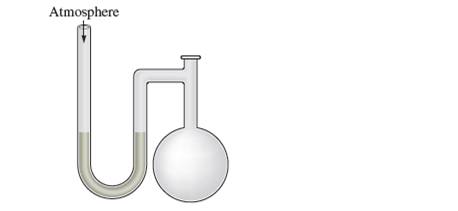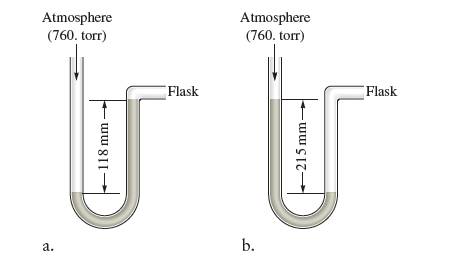
Chemical Principles
8th Edition
ISBN: 9781305581982
Author: Steven S. Zumdahl, Donald J. DeCoste
Publisher: Cengage Learning
expand_more
expand_more
format_list_bulleted
Concept explainers
Textbook Question
Chapter 5, Problem 22E
A diagram for an open-tube manometer is shown below.

If the flask is open to the atmosphere, the mercury levelsare equal. For each of the following situations in whicha gas is contained in the flask, calculate the pressure inthe flask in torr, atmospheres, and pascals.

c. Calculate the pressures in the flask in parts a and b(in torr) if the atmospheric pressure is 635 torr.
Expert Solution & Answer
Want to see the full answer?
Check out a sample textbook solution
Chapter 5 Solutions
Chemical Principles
Ch. 5 - Consider the following apparatus: a test tube...Ch. 5 - Prob. 2DQCh. 5 - Prob. 3DQCh. 5 - Prob. 4DQCh. 5 - Prob. 5DQCh. 5 - Prob. 6DQCh. 5 - Prob. 7DQCh. 5 - Prob. 8DQCh. 5 - Prob. 9DQCh. 5 - Prob. 10DQ
Ch. 5 - Prob. 11DQCh. 5 - Prob. 12DQCh. 5 - Prob. 13DQCh. 5 - Prob. 14DQCh. 5 - Prob. 15DQCh. 5 - Prob. 16DQCh. 5 - Prob. 17DQCh. 5 - For each of the quantities (af) listed below,...Ch. 5 - Prob. 19DQCh. 5 - Prob. 20DQCh. 5 - A sealed-tube manometer as shown below can be...Ch. 5 - A diagram for an open-tube manometer is shown...Ch. 5 - Prob. 23ECh. 5 - Prob. 24ECh. 5 - A gauge on a compressed gas cylinder reads 2200...Ch. 5 - Prob. 26ECh. 5 - Prob. 27ECh. 5 - Prob. 28ECh. 5 - Prob. 29ECh. 5 - Prob. 30ECh. 5 - A mixture of 1.00 g H2 and 1.00 g He is placed in...Ch. 5 - Prob. 32ECh. 5 - Prob. 33ECh. 5 - Prob. 34ECh. 5 - A piece of solid carbon dioxide, with a mass of...Ch. 5 - Prob. 36ECh. 5 - Suppose two 200.0-L tanks are to be filled...Ch. 5 - Prob. 38ECh. 5 - Prob. 39ECh. 5 - Prob. 40ECh. 5 - Prob. 41ECh. 5 - Prob. 42ECh. 5 - Prob. 43ECh. 5 - Prob. 44ECh. 5 - Prob. 45ECh. 5 - A sample of nitrogen gas was collected over water...Ch. 5 - Prob. 47ECh. 5 - Prob. 48ECh. 5 - Prob. 49ECh. 5 - A 1.00-L gas sample at 100.°C and 600. torr...Ch. 5 - Prob. 51ECh. 5 - Given that a sample of air is made up of nitrogen,...Ch. 5 - Prob. 53ECh. 5 - Prob. 54ECh. 5 - A compound contains only nitrogen and hydrogen and...Ch. 5 - A compound has the empirical formula CHCl. A...Ch. 5 - One of the chemical controversies of the...Ch. 5 - Discrepancies in the experimental values of the...Ch. 5 - A sample of methane (CH4) gas contains a small...Ch. 5 - Prob. 60ECh. 5 - Prob. 61ECh. 5 - Urea (H2NCONH2) is used extensively as a...Ch. 5 - Methanol (CH3OH) can be produced by the...Ch. 5 - Consider the reaction between 50.0 mL of liquid...Ch. 5 - Some very effective rocket fuels are composed of...Ch. 5 - Air bags are activated when a severe impact causes...Ch. 5 - Prob. 67ECh. 5 - Prob. 68ECh. 5 - Prob. 69ECh. 5 - Xenon and fluorine will react to form binary...Ch. 5 - The nitrogen content of organic compounds can be...Ch. 5 - Prob. 72ECh. 5 - Prob. 73ECh. 5 - Consider the following balanced equation in which...Ch. 5 - Prob. 75ECh. 5 - Prob. 76ECh. 5 - Prob. 77ECh. 5 - Prob. 78ECh. 5 - Prob. 79ECh. 5 - Prob. 80ECh. 5 - Calculate the average kinetic energies of the...Ch. 5 - Prob. 82ECh. 5 - Prob. 83ECh. 5 - Prob. 84ECh. 5 - Prob. 85ECh. 5 - Prob. 86ECh. 5 - Prob. 87ECh. 5 - One way of separating oxygen isotopes is by...Ch. 5 - A compound contains only C, H, and N. It is 58.51%...Ch. 5 - Prob. 90ECh. 5 - Prob. 91ECh. 5 - Prob. 92ECh. 5 - Why do real gases not always behave ideally?...Ch. 5 - Prob. 94ECh. 5 - Prob. 95ECh. 5 - Without looking at tables of values, which of the...Ch. 5 - Prob. 97ECh. 5 - Prob. 98ECh. 5 - Prob. 99ECh. 5 - Prob. 100ECh. 5 - Prob. 101ECh. 5 - Prob. 102ECh. 5 - Consider separate 1.0-L samples of O2(g) and...Ch. 5 - Consider separate 1.00-L samples of Ar(g), both...Ch. 5 - Calculate the intermolecular collision frequency...Ch. 5 - Prob. 106ECh. 5 - Prob. 107ECh. 5 - Prob. 108ECh. 5 - Prob. 109ECh. 5 - Prob. 110ECh. 5 - Prob. 111ECh. 5 - Prob. 112AECh. 5 - Prob. 113AECh. 5 - Prob. 114AECh. 5 - Prob. 115AECh. 5 - Prob. 116AECh. 5 - Prob. 117AECh. 5 - Prob. 118AECh. 5 - A 2.747-g sample of manganese metal is reacted...Ch. 5 - Prob. 120AECh. 5 - At STP, 1.0 L Br2 reacts completely with 3.0 L F2...Ch. 5 - Prob. 122AECh. 5 - Prob. 123AECh. 5 - Prob. 124AECh. 5 - Prob. 125AECh. 5 - Prob. 126AECh. 5 - Prob. 127AECh. 5 - Prob. 128AECh. 5 - Prob. 129AECh. 5 - Prob. 130AECh. 5 - Prob. 131AECh. 5 - Prob. 132AECh. 5 - Prob. 133AECh. 5 - Prob. 134AECh. 5 - Prob. 135AECh. 5 - Prob. 136AECh. 5 - Prob. 137AECh. 5 - Prob. 138AECh. 5 - Prob. 139AECh. 5 - Prob. 140AECh. 5 - Prob. 141AECh. 5 - Prob. 142AECh. 5 - Prob. 143AECh. 5 - Prob. 144AECh. 5 - Prob. 145AECh. 5 - Prob. 146CPCh. 5 - A 16.0-g sample of methane (CH4) reacts with 64.0...Ch. 5 - You have two samples of helium gas at the same...Ch. 5 - Prob. 149CPCh. 5 - Prob. 150CPCh. 5 - Prob. 151CPCh. 5 - Prob. 152CPCh. 5 - The density of a pure gaseous compound was...Ch. 5 - Prob. 154CPCh. 5 - The most probable velocity ump is the velocity...Ch. 5 - Derive Dalton’s law of partial pressures from the...Ch. 5 - One of the assumptions of the kinetic molecular...Ch. 5 - Prob. 158CPCh. 5 - A steel cylinder contains 5.00 moles of graphite...Ch. 5 - Prob. 160CPCh. 5 - Prob. 161CPCh. 5 - Prob. 162CPCh. 5 - Calculate the number of stages needed to change...Ch. 5 - Prob. 164CPCh. 5 - You have a helium balloon at 1.00 atm and 25°C....Ch. 5 - Prob. 166CPCh. 5 - Prob. 167MP
Knowledge Booster
Learn more about
Need a deep-dive on the concept behind this application? Look no further. Learn more about this topic, chemistry and related others by exploring similar questions and additional content below.Similar questions
- Shown below are three containers of an ideal gas (A, B, and C), each equipped with a movable piston (assume that atmospheric pressure is 1.0 atm). a How do the pressures in these containers compare? b Are all the gases at the same temperature? If not, compare the temperatures. c If you cooled each of the containers in an ice-water bath to 0.0C, describe how the volumes and pressures of the gases in these containers would compare.arrow_forward50 The first step in processing zinc metal from its ore, ZnS, is to react it with O2 according to the reaction 2ZnS(s)+3O2(g)2ZnO(s)+2SO2(g) If 620 kg of ZnS is to be reacted, what volume of oxygen at 0.977 atm 34.0 C is needed (at a minimum) to carry out this reaction?arrow_forwardHydrogen gas is used in weather balloon because it is less expensive than Helium. Assume that 5.57 g of H2 is used to fill a weather balloon to an initial volume of 67 L at 1.04 atm. If the ballloon rises to an altitude where the pressure is 0.047 atm, what is its new volume? Assume that the temperature remains constant.arrow_forward
- A sample of a compound of xenon and fluorine was confined in a bulb with a pressure of 18 tor. Hydrogen was added to the bulb until the pressure was 72 torr. Passage of an electric spark through the mixture produced Xe and HF. After the HF was removed by reaction with solid KOH, the final pressure of xenon and unreacted hydrogen in the bulb was 36 torr. What is the empirical formula of the xenon fluoride in the original sample? (Note: Xenon fluorides contain only one xenon atom per molecule.)arrow_forwardWorkers at a research station in the Antarctic collected a sample of air to test for airborne pollutants. They collected the sample in a 1.00-L container at 764 torr and 20 C. Calculate the pressure in the container when it was opened for analysis in a particulate-free clean room in a laboratory in South Carolina, at a temperature of 22 C.arrow_forwardcertain flexible weather balloon contains helium gas at a volume of 855L. Initially, the balloon is at sea level where the temperature is 25 °C and the barometric pressure is 730torr. The balloon men rises to an altitude of 6000 ft, where the pressure is 605torr and the temperature is 15C. What is the change in volume of the balloon as it ascends from sea level to 6000ft?arrow_forward
arrow_back_ios
arrow_forward_ios
Recommended textbooks for you
 Introductory Chemistry: An Active Learning Approa...ChemistryISBN:9781305079250Author:Mark S. Cracolice, Ed PetersPublisher:Cengage Learning
Introductory Chemistry: An Active Learning Approa...ChemistryISBN:9781305079250Author:Mark S. Cracolice, Ed PetersPublisher:Cengage Learning ChemistryChemistryISBN:9781305957404Author:Steven S. Zumdahl, Susan A. Zumdahl, Donald J. DeCostePublisher:Cengage Learning
ChemistryChemistryISBN:9781305957404Author:Steven S. Zumdahl, Susan A. Zumdahl, Donald J. DeCostePublisher:Cengage Learning Chemistry: An Atoms First ApproachChemistryISBN:9781305079243Author:Steven S. Zumdahl, Susan A. ZumdahlPublisher:Cengage Learning
Chemistry: An Atoms First ApproachChemistryISBN:9781305079243Author:Steven S. Zumdahl, Susan A. ZumdahlPublisher:Cengage Learning
 Chemistry: Principles and PracticeChemistryISBN:9780534420123Author:Daniel L. Reger, Scott R. Goode, David W. Ball, Edward MercerPublisher:Cengage Learning
Chemistry: Principles and PracticeChemistryISBN:9780534420123Author:Daniel L. Reger, Scott R. Goode, David W. Ball, Edward MercerPublisher:Cengage Learning Chemistry: The Molecular ScienceChemistryISBN:9781285199047Author:John W. Moore, Conrad L. StanitskiPublisher:Cengage Learning
Chemistry: The Molecular ScienceChemistryISBN:9781285199047Author:John W. Moore, Conrad L. StanitskiPublisher:Cengage Learning

Introductory Chemistry: An Active Learning Approa...
Chemistry
ISBN:9781305079250
Author:Mark S. Cracolice, Ed Peters
Publisher:Cengage Learning

Chemistry
Chemistry
ISBN:9781305957404
Author:Steven S. Zumdahl, Susan A. Zumdahl, Donald J. DeCoste
Publisher:Cengage Learning

Chemistry: An Atoms First Approach
Chemistry
ISBN:9781305079243
Author:Steven S. Zumdahl, Susan A. Zumdahl
Publisher:Cengage Learning


Chemistry: Principles and Practice
Chemistry
ISBN:9780534420123
Author:Daniel L. Reger, Scott R. Goode, David W. Ball, Edward Mercer
Publisher:Cengage Learning

Chemistry: The Molecular Science
Chemistry
ISBN:9781285199047
Author:John W. Moore, Conrad L. Stanitski
Publisher:Cengage Learning
Step by Step Stoichiometry Practice Problems | How to Pass ChemistryMole Conversions Made Easy: How to Convert Between Grams and Moles; Author: Ketzbook;https://www.youtube.com/watch?v=b2raanVWU6c;License: Standard YouTube License, CC-BY